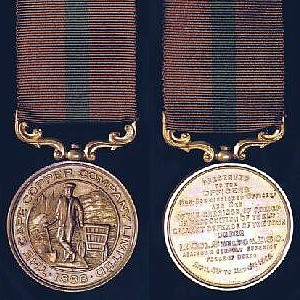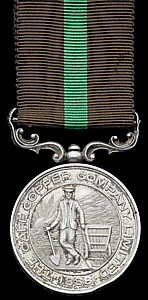Cape Copper Company Medal for the Defence of O'okiep facts for kids
Quick facts for kids Cape Copper Company Medal for the Defence of O'okiep |
|
|---|---|
 |
|
| Country | |
| Type | Campaign medal |
| Eligibility | O'okiep Garrison members |
| Awarded for | Defence of the town during the siege of O'okiep in 1902 |
| Campaign(s) | Second Boer War |
| Status | Unofficial |
| Statistics | |
| Established | 1902 |
| Related | |
Ribbon bar |
|
The Cape Copper Company Medal for the Defence of O'okiep is a special medal. It was created by a company called the Cape Copper Company in 1902. This medal was given to people who bravely defended the town of O'okiep in South Africa.
O'okiep was under attack during the Second Boer War. The medal was given to soldiers and townspeople who protected O'okiep from 4 April to 4 May 1902. This happened near the end of the war.
Contents
The Cape Copper Company
The Cape Copper Company was a mining company. It started around 1862 or 1863. Its main job was to mine copper in an area called Namaqualand, near O'okiep. The company was very important to the town.
The Siege of O'okiep
Towards the end of the Second Boer War, Boer commandos (groups of soldiers) entered the Cape of Good Hope. On 4 April 1902, a town called Concordia, near O'okiep, surrendered to the Boer forces.
From 4 April to 4 May, the town of O'okiep was surrounded. The Boer forces were led by General Jan Smuts. Their plan was to take control of the rich copper mines. They hoped this would make the British send troops from Cape Town to O'okiep. This would then leave Cape Town open to attack.
Defending the Town
About 900 people defended O'okiep. Their leader was Lieutenant Colonel W.A.D. Shelton. The defenders included soldiers and local miners. Many of the civilian defenders worked for the Cape Copper Company. About three-quarters of them were Coloured people.
The town had built many strong defensive spots. These included blockhouses, which are small forts. Early in the siege, the defenders successfully fought off several strong attacks. Later, General Smuts left to attend peace talks. This meant the war was ending, and the siege became less intense.
The Dynamite Train Attack
On 1 May 1902, the Boer commandos tried a new attack. They used a train engine called "Pioneer." This engine pushed a wagon full of dynamite towards O'okiep. It was like a mobile bomb.
The defenders had a barbed wire fence across the railway line. This fence was connected to the train tracks. When the dynamite wagon hit the fence, it derailed. This made the dynamite spill onto the ground. Luckily, it just burned without exploding.
General Jan Smuts later said that the railway was still working. But because there were women and children in O'okiep, the commandos were only allowed to scare the town. They made sure the dynamite would not explode.
The O'okiep Defence Medal
After the war, the British government gave out medals. These were the Queen's South Africa Medal and the King's South Africa Medal. These medals were for regular soldiers who had served in the war.
However, the Coloured members of the O'okiep defence could not receive these official medals. So, the Cape Copper Company decided to create its own medal. They wanted to give it to everyone who defended O'okiep, no matter their background.
Medal Types
Two types of the Cape Copper Company Medal were made.
- Most of the medals were made of bronze. These were given to the regular soldiers and civilian defenders. Many of these were mine workers.
- A silver medal was given to officers and higher-ranking mine officials. One non-commissioned officer, Paymaster Sergeant Harry Rodda, also received a silver medal.
What the Medal Looks Like
The Cape Copper Company Medal is round, about 3.65 centimetres across. It has a raised edge.
- Front (Obverse): The front shows the company's symbol. This is a miner with a spade standing next to a mining cart. It also says "1888" and "THE CAPE COPPER COMPANY LIMITED" around the edge.
- Back (Reverse): The back is smooth with a raised edge. It has a message written on it. This message thanks the officers, non-commissioned officers, and men of O'okiep. It praises their brave defence of the town against a much larger Boer force from 4 April to 4 May 1902. It also mentions their leader, Lt. Col. Shelton.
- Ribbon: The ribbon is about 3.2 centimetres wide. It is dark brown with a green stripe in the middle.
How the Medal Hangs
The medal hangs from a fancy hanger. This hanger is similar to one used on the India General Service Medal of 1936. It is attached to the medal with a pin, allowing the medal to swing.
Important Unofficial Medals
Some military medals are not officially approved by the government. They are called "unofficial." This means they could not be worn with military uniforms. However, some of these unofficial medals have become very well-known in South Africa's history.
Four of these unofficial medals are considered very important:
- The Sir Harry Smith's Medal for Gallantry from 1851.
- The Johannesburg Vrijwilliger Corps Medal from 1899.
- The Kimberley Star from 1900.
- The Cape Copper Company Medal for the Defence of O'okiep from 1902.
Images for kids



